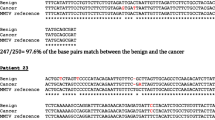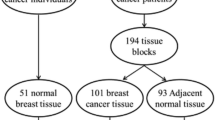Abstract
Mouse mammary tumor virus (MMTV) has a proven role in breast carcinogenesis in wild mice and genetically susceptible laboratory inbred mice. The carcinogenic characteristics of this virus are enhanced by estrogen and other steroid hormones. MMTV-like envelope gene sequences, with 95% homology to MMTV have been identified in approximately 40% of breast cancers in US, Australian and Argentinian women. The presence of such sequences indicates the presence of a replication competent MMTV-like virus in human breast tumors. Whether an MMTV-like virus contributes to human breast cancer remains to be demonstrated. Non-statistically significant differences in p53 expression between MMTV-like positive and negative human breast cancers have previously been observed. As high p53 protein expression is associated with aggressive breast carcinogenesis we sought to determine if there were associations between the presence of MMTV-like gene sequences and elevated p53 expression in both invasive ductal carcinomas (IDC) and ductal carcinomas in situ (DCIS). We also investigated the expression of other biomarkers which are commonly associated with human breast cancer. These included estrogen receptor, progesterone receptor, Ki67, Cyclin D1, Bcl-2 and HER-2. Using polymerase chain reaction (PCR) analyses, MMTV-like envelope gene sequences were detected in 15 (75%) of 20 IDC specimens and 5 (23%) of 22 DCIS specimens. The average percentage of p53 positive cells in MMTV-like positive IDC specimens was 69% as compared to 44% in MMTV-like negative specimens (p for difference = 0.067). The average percentage of p53 positive cells in MMTV-like positive DCIS specimens was 93% as compared to 35% in MMTV-like negative specimens (numbers too few for statistical analysis). There was an increased intensity of p53 expression in IDC and DCIS specimens that were MMTV-like positive compared to those that were MMTV-like negative. There were no statistically significant differences in age, grade, and percentage of average positive cells for ERa, PR, Ki67, cyclin D1, Bcl-2, and HER-2, between MMTV-like positive and negative breast cancer specimens. Although these observations do not provide evidence of causality, they are consistent with a role for MMTV-like viruses in some human breast cancers.
Similar content being viewed by others
References
Bittner JJ: Possible relationship of the oestrogenic hor-mones,genetic susceptibility and milk influence in the production of mammary cancer in mice. Cancer Res 2:710–721, 1943
Callahan R, Smith GH; MMTV-induced mammary tmu-morigenesis: gene discovery, progression to malignancy and cellular pathways. Oncogene 19:992–1001, 2000
Wang Y, Holland JF, Bleiweiss IJ, Melana S, Liu X, Pelisson I, et al.: Detection of mammary tumor virus ENV gene like sequences in human breast cancer. Cancer Res 55: 5173–5179, 1995
Etkind P. Du J, Khan A, Pillitteri J, Wiernik PH: Mouse mammary tumor virus-like ENV gene sequences in human breast tumors and a lymphoma of a breast cancer patient. Clin Cancer Res 6:1273–1278, 2000
Wang Y, Pelisson I, Melana SM, Holland JF, Pogo B G-T: Detection of MMTV–like LTR and LTR–env gene sequences in human breast cancer. Int J Oncol 18:1041–1044, 2001
Ford CE, Tran D, Deng YM, Rawlinson WD, Lawson JS: Mouse mammary tumour like virus prevalence in breast tumours of Australian and Vietnamese women. Clin Cancer Res 9:1118–1120, 2003
Melana SM, Picconi MA, Rossi C, Mural J, Alonio LV, Teyssie A, Holland JF, Pogo BGT: Detection of murine mammary tumor virus (MMTV)env gene-like sequences in breast cancer from Argentie patients. Medicina 62:323–327, 2002
Liu B, Wang Y, Melana SM, Pelisson I, Najfield V, Holland JF, Pogo BGT: Identification of a proviral structure in human breast cancer. Cancer Res 61:1754–1759, 2001
Mesa-Tejada R, Keydar I, Ramanarayanan M, Ohno T, Fenoglio C, Spiegelman S: Detection in human breast carcinomas of an antigen immunologically related to a group specific antigen of mouse mammary tumor virus. Proc Natl Acad Sci, USA 75:1529–1533, 1978
Moore DH, Charney J, Kramarsky B, Lasfragues EY, Sarkar NH, Brennan MJ, Burrows JH, Sirsat SM, Pay-master JC, Vaidya AB: Search for a human breast cancer virus. Nature 229:611–615, 1971
Day NK, Witkin SS, Sarkar NH, Kinne D, Jussawalla DJ, Levin A, Hsia CC, Geller N, Good RA: Antibodies reactive with murine mammary tumor virus in sera of patients with breast cancer: geographic and family studies. Proc Natl Acad Sci USA 78:2483–2487, 1981
Witkin SS, Sarkar NH, Kinne DW, Breed CN, Good RA, Day NK: Antigens and antibodies cross-reactive to the murine mammary tumor virus in human cyst fluids. J Clin Invest 67:216–222, 1981
Litvinov SV, Golovkina TV: Expression of proteins immu-nologically related to murine mammary tumor virus (MMTV)core proteins in the cells of breast cancer continuous lines MCF-7, T47D, MDA-231 and cells from human milk. Acta Virol 33:137–142, 1989
Pogo BG-T, Melana SM, Holland JF, Mandeli JF, Pilotti S, Casalini P, Menard S: Sequences homologous to the mouse mammary tumor virus env gene in human breast carcinoma correlate with overexpression of laminin recep-tor. Clin Cancer Res 5:2108–2111, 1999
Menard S, Casalini P, Tomasic G, Pilotti S, Cascinelli N, Bufalino R, Perrone F, Rilke F, Colnaghi I: Pathobiologic identification of two distinct breast carcinoma syndromes with diverging clinical behaviours. Breast Cancer Res Treat 55:169–177, 1999
Walker RA, Dearing SJ, Lane DP, Varley JM: Expression of p53 protein in in ltrating and in situ breast carcinomas. J Pathol 165:203–211, 1991
Bur ME, Zimarowski MJ, Schnitt SJ, Baker S, Lew R: Estrogen receptor immunohistochemistry in carcinoma in situ of the breast. Cancer 69:1174–1181, 1992
Rohan TE, Hartwick W, Miller AB, Kandel RA: Immu-nohistochemical detection of c-erbB-2 and p53 in benign breast disease and breast cancer risk. J Natl Cancer Inst 90: 1262–1269, 1998
Alle KM, Henshall SM, Field AS, Sutherland RL: Cyclin D1 protein is overexpressed in hyperplasia and intraductal carcinoma of the breast. Clin Cancer Res 4:847–854, 1998
Lawson JS, Field AS, Champion S, Tran D, Ishikura H, Trichopoulos D: Low oestrogen receptor alpha expression in normal breast tissue underlies low breast cancer incidence in Japan. Lancet 354:1787–1788, 1999
Mowat M, Cheng A, Kimura N, Bernstein A, Benchimol S: Rearrangements of the cellular p53 gene in erythroleukae-mic cells transformed by Friend virus. Nature 314:633–636, 1985.
Author information
Authors and Affiliations
Rights and permissions
About this article
Cite this article
Lawson, J.S., Tran, D.D., Ford, C. et al. Elevated Expression of the Tumor Suppressing Protein p53 is Associated with the Presence of Mouse Mammary Tumor-Like env Gene Sequences (MMTV-like) in Human Breast Cancer. Breast Cancer Res Treat 87, 13–17 (2004). https://doi.org/10.1023/B:BREA.0000041573.09142.00
Issue Date:
DOI: https://doi.org/10.1023/B:BREA.0000041573.09142.00




